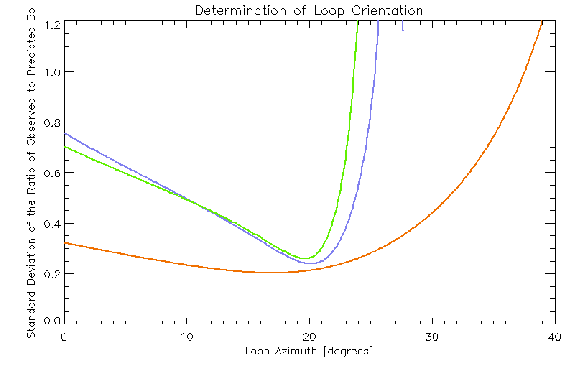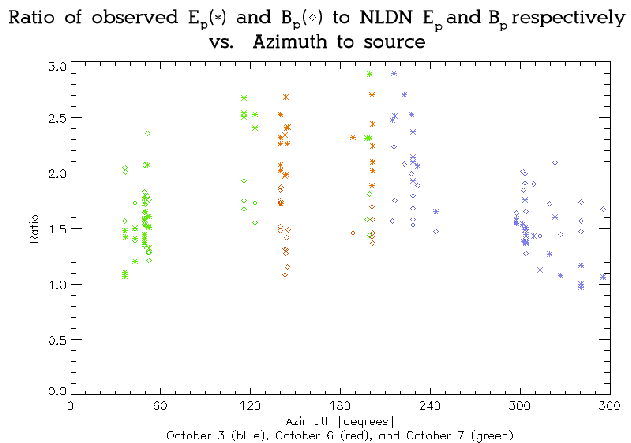Electric and magnetic field data was acquired on the Magdalena Ridge at Langmuir Laboratory in 1997. The electric field would have been significantly enhanced on the ridge. The NLDN data will be used to determine the amount of electric field enhancement caused by the ridge and to properly calibrate the magnetic field instrument.
The magnetic field instrument was borrowed from Chris Barrington-Leigh
of Stanford University. The magnetic field sensor consisted of a wire
which was looped multiple times around the perphery of a square frame.
The absolute sensitivity of the wire-loop and amplifier was
calibrated. It was found that a change of 1.5 nT in the magnetic
field component normal to the plane of the wire loop produced an
output of ![]() 1 V. However, significant errors may exist in the
calibration procedure which was used in 1997 (C. Barrington-Leigh, private communication, 1998).
1 V. However, significant errors may exist in the
calibration procedure which was used in 1997 (C. Barrington-Leigh, private communication, 1998).
A well known result from electrodynamics is that at sufficient
distances from an electromagnetic source, the magnetic field is
related to the electric field by the simple relationship, ![]() .
Substituting this relationship into Equation B.3 gives:
.
Substituting this relationship into Equation B.3 gives:
where ![]() is the peak magnetic field and
is the peak magnetic field and ![]() is the
free-space permeability (
is the
free-space permeability (
![]() ).
).
Near the ground, the electric field will be vertical while the
magnetic field will be tangential to a circle centered on the current
source. The magnetic field which is measured by the instrument is the
component which is normal to the plane of the loop. ![]() is related
to the measured peak magnetic field,
is related
to the measured peak magnetic field, ![]() , by the trigonometric
relationship:
, by the trigonometric
relationship:
where ![]() is the azimuth of the normal to the plane
of the loop and
is the azimuth of the normal to the plane
of the loop and ![]() is the azimuth to the source current. The
null in sensitivity (
is the azimuth to the source current. The
null in sensitivity (
![]() ) occurs when these azimuths are
either identical or
) occurs when these azimuths are
either identical or ![]() apart.
apart.
The ![]() value could have been determined from a compass, but
this was not done accurately. The loop orientation can be found
accurately by determining where
value could have been determined from a compass, but
this was not done accurately. The loop orientation can be found
accurately by determining where ![]() produces measured
produces measured ![]() values which are consistent with the predicted
values which are consistent with the predicted ![]() values.
values.
Figure B.6 shows the standard deviation of the
ratio of ![]() calculated from Equation B.8 based on
measured
calculated from Equation B.8 based on
measured ![]() values and the
values and the ![]() values provided by NLDN to
values provided by NLDN to
![]() calculated from Equation B.7 based on the NLDN
calculated from Equation B.7 based on the NLDN ![]() and
and ![]() values. The standard deviation of the ratio is shown as a
function of
values. The standard deviation of the ratio is shown as a
function of ![]() for the three different days on which
high-speed video of sprites was obtained: October 3 (blue), October 6
(red), and October 7 (green) 1997. The agreement between the magnetic
field values calculated by the two techniques increases as the
standard deviation decreases. The minimum standard deviation of the
ratio near
for the three different days on which
high-speed video of sprites was obtained: October 3 (blue), October 6
(red), and October 7 (green) 1997. The agreement between the magnetic
field values calculated by the two techniques increases as the
standard deviation decreases. The minimum standard deviation of the
ratio near
![]() azimuth corresponds to the
orientation of the normal to the plane of the loop on all three days.
The October 3 and 7 data is particularly sensitive to loop orientation
since there were storms near one of the two nulls in loop sensitivity
on both days, albeit for a different null on each day.
azimuth corresponds to the
orientation of the normal to the plane of the loop on all three days.
The October 3 and 7 data is particularly sensitive to loop orientation
since there were storms near one of the two nulls in loop sensitivity
on both days, albeit for a different null on each day.
 |
Equations B.7 and B.8 were used to calculate
the expected ![]() values based on NLDN data and a loop orientation of
values based on NLDN data and a loop orientation of
![]() . Equation B.3 was used to calculate the
expected
. Equation B.3 was used to calculate the
expected ![]() values based on NLDN data. Figure B.7
shows the ratio of the observed
values based on NLDN data. Figure B.7
shows the ratio of the observed ![]() and
and ![]() values to the
values to the ![]() and
and ![]() values calculated from NLDN data, respectively, as a
function of azimuth to the stroke. The observed
values calculated from NLDN data, respectively, as a
function of azimuth to the stroke. The observed ![]() values are
about 1.6 times greater than predicted and this enhancement factor
appears to be independent of the azimuth to the source.
values are
about 1.6 times greater than predicted and this enhancement factor
appears to be independent of the azimuth to the source.
 |
A new calibration factor of ![]() nT/V was used to convert
digitized magnetic data (with a known conversion factor between
digital units and volts) to corresponding magnetic field values. The
charge moment change calculations reported in Chapter 5
were based on the
nT/V was used to convert
digitized magnetic data (with a known conversion factor between
digital units and volts) to corresponding magnetic field values. The
charge moment change calculations reported in Chapter 5
were based on the ![]() nT/V conversion factor. The net effect of
the NLDN-based calibration was to reduce the calculated charge moment
values by about 40% from those based on the calibration of the
magnetic field instrument.
nT/V conversion factor. The net effect of
the NLDN-based calibration was to reduce the calculated charge moment
values by about 40% from those based on the calibration of the
magnetic field instrument.
No attempt was made to account for attenuation (see
Equation B.4) in the calculations, since the attenuation
exponents for the region around Langmuir are not known. However, NLDN
strokes between 50 and 200 km range were analyzed using the
Florida-based attenuation factors to see how including attenuation
might effect the calibration. It was found that the observed ![]() values were about 1.85 times greater than the predicted
values were about 1.85 times greater than the predicted ![]() values,
an enhancement which is only 16% greater than the enhancement which
was calculated without any attenuation.
values,
an enhancement which is only 16% greater than the enhancement which
was calculated without any attenuation.
The observed ![]() values were roughly a factor of two greater than
the
values were roughly a factor of two greater than
the ![]() values based on NLDN data. The electric field enhancement
was expected since the electric field meter was on a mountain ridge.
However, the variation of the enhancement factor with source azimuth
was not expected. It is speculated that this variation may be due to
the presence of nearby metallic trailers and other conductive
obstructions. The magnetic loop antenna was placed in an open field
further away from the balloon hangar, so it would not have been
subject to the same complications.
values based on NLDN data. The electric field enhancement
was expected since the electric field meter was on a mountain ridge.
However, the variation of the enhancement factor with source azimuth
was not expected. It is speculated that this variation may be due to
the presence of nearby metallic trailers and other conductive
obstructions. The magnetic loop antenna was placed in an open field
further away from the balloon hangar, so it would not have been
subject to the same complications.